Heterobasidion Root Disease
(previously called annosus root disease)
Heterobasidion occidentale
Heterobasidion irregulare
Key Wildlife Value:
Heterobasidion root disease creates down wood, short-term snags, and occasional tree base hollows by killing and decaying the root system and butts of host trees. Concentrations of down wood that vary in density and arrangement typically occur in root disease infection areas, usually with a corresponding decrease in canopy cover. Canopy gaps caused by heterobasidion root disease expand slowly, resulting in a more diverse stand structure and at times a more diverse plant species composition, as resistant or non-host trees, shrubs, and forbs are released or become established behind the slowly expanding fringe of dying host trees. Bark beetles frequently are attracted to infected trees, providing good foraging habitat for woodpeckers. Infected trees with extensive butt rot, especially old western hemlocks growing in coastal areas, sometimes become hollow at their bases. Although the degree of wildlife use of trees hollowed at the base by heterobasidion root disease is not well known, these trees potentially could provide denning habitat while standing, or while lying on the ground if they fall with a sufficient amount of their hollow bases intact. However, the likelihood of a standing infected tree breaking at a base decayed extensively enough to be hollow is fairly high.
Distribution in Oregon and Washington:
Found throughout both states. (See also Important Habitats and Spread Dynamics).
Hosts:
Susceptibility and damage vary greatly by Heterobasidion species, tree species (Table.fid-2) and location.
H. occidentale affects many species of western conifers. Primary hosts in Oregon and Washington are Abies spp., Tsuga spp., Douglas-fir, and Picea spp. Grand fir and white fir east of the Cascades crest (Eastside) and in southwest Oregon are frequently killed. Other species are less likely to be killed, but some may develop extensive decay and experience breakage and windthrow. Douglas-fir may be severely damaged in some Eastside locations. Large western hemlocks growing west of the Cascades crest that are older than 120 years are frequently butt-rotted and may develop hollow butts. H. occidentale commonly causes extensive decay and breakage in old-growth mountain hemlock stands. Although stumps of non-host pines and junipers growing in mixed conifer stands frequently are colonized by H. occidentale, the pathogen does not spread from infected non-host stumps to cause root disease in adjacent host trees.
H. irregulare affects a broad range of conifer and hardwood tree species. Primary hosts in Oregon and Washington are Pinus spp. and western juniper growing on the Eastside, where it frequently kills ponderosa pine and associated western juniper growing on very dry sites near the forest/non-forest interface. Other pine species are rarely killed.
Diagnosis:
Heterobasidion root disease is often difficult to identify because it causes variable symptoms and diagnostic fruiting bodies may be hard to find. It sometimes is effective to arrive at a diagnosis after methodically eliminating the possibility of other major root diseases. Advanced decay characteristics are useful for diagnosis. However, the most reliable way to diagnose heterobasidion root disease is to find fruiting bodies. Fruiting bodies of H. occidentale and H. irregulare look alike, and may be present in infected trees or stumps in the form of small light-colored pustules or button conks, or larger woody crust-like or shelving conks. Once heterobasidion root disease is diagnosed, identification of the Heterobasidion species is based on host tree species.
Snags, stumps and the roots of windthrown trees provide good locations to examine decay. The best place to look on a standing tree or stump usually is on a root below the soil line, but characteristic decay sometimes is also apparent in the aboveground portions of a stump. Advanced decay is either 1) laminated
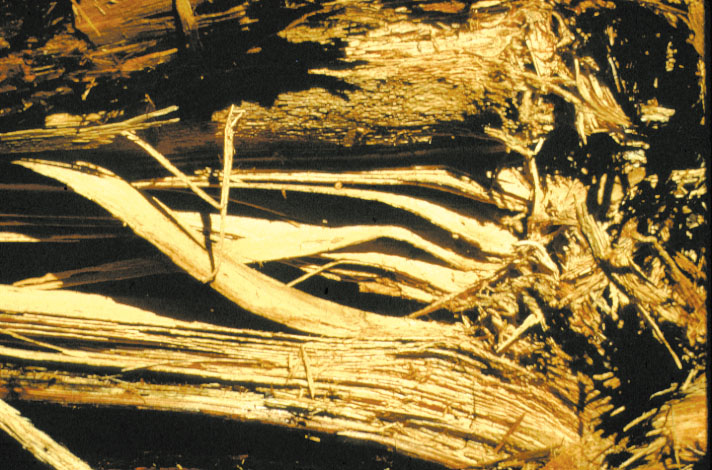

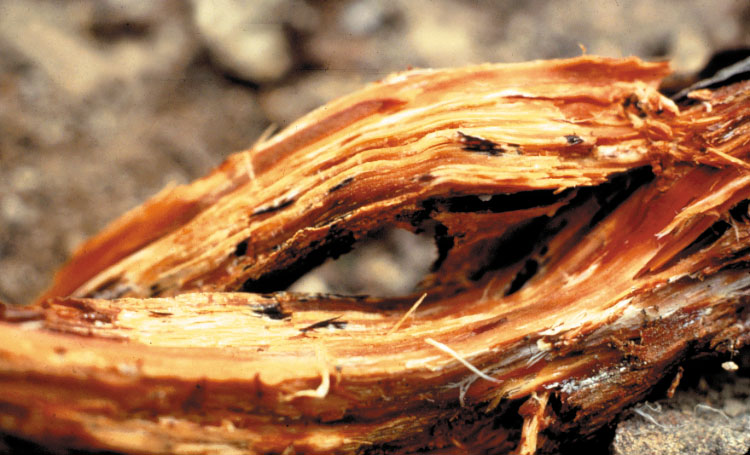
Look for diagnostic fruiting bodies on dead trees by pulling away the duff and examining below the root collar and on the roots for small, leathery, buff to white pustules or popcorn-like “button conks.” Larger, mature fruiting bodies (conks) sometimes may be found inside nearby hollow or extensively decayed stumps.
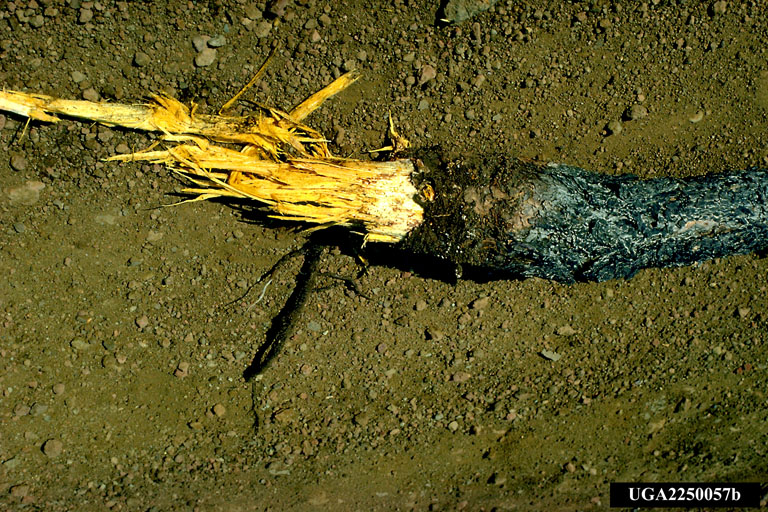
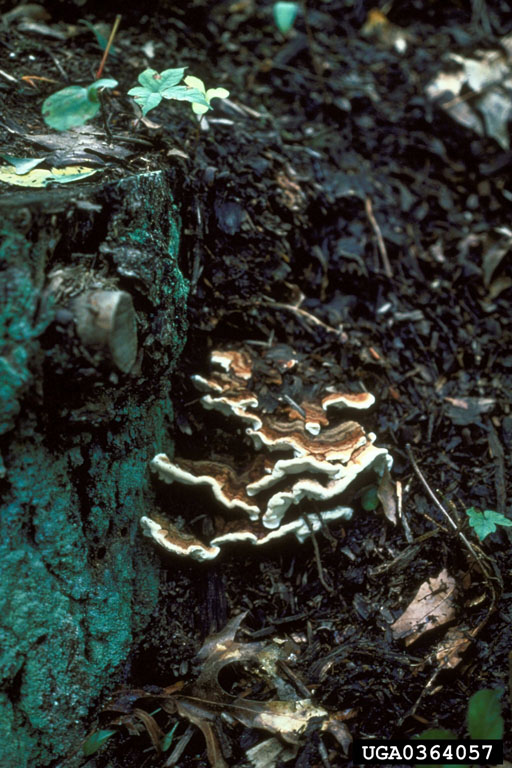
In seedling/sapling/pole-size stands regenerated following harvest activities, look for a pattern of dead or missing trees associated with large stumps.
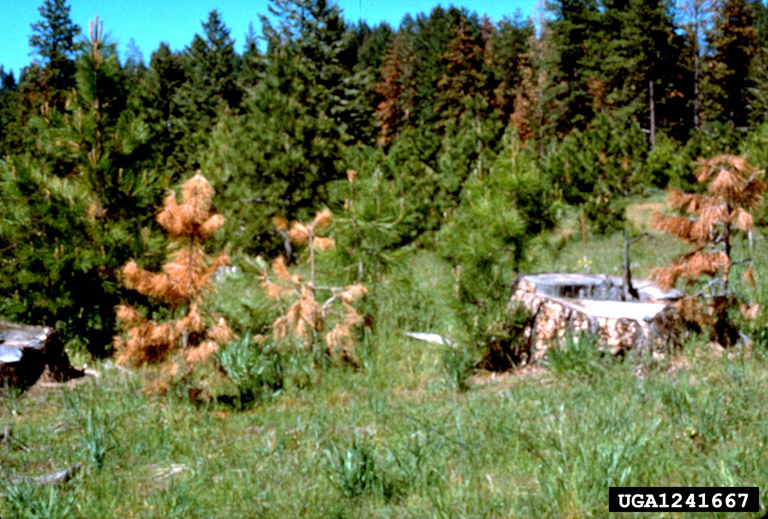
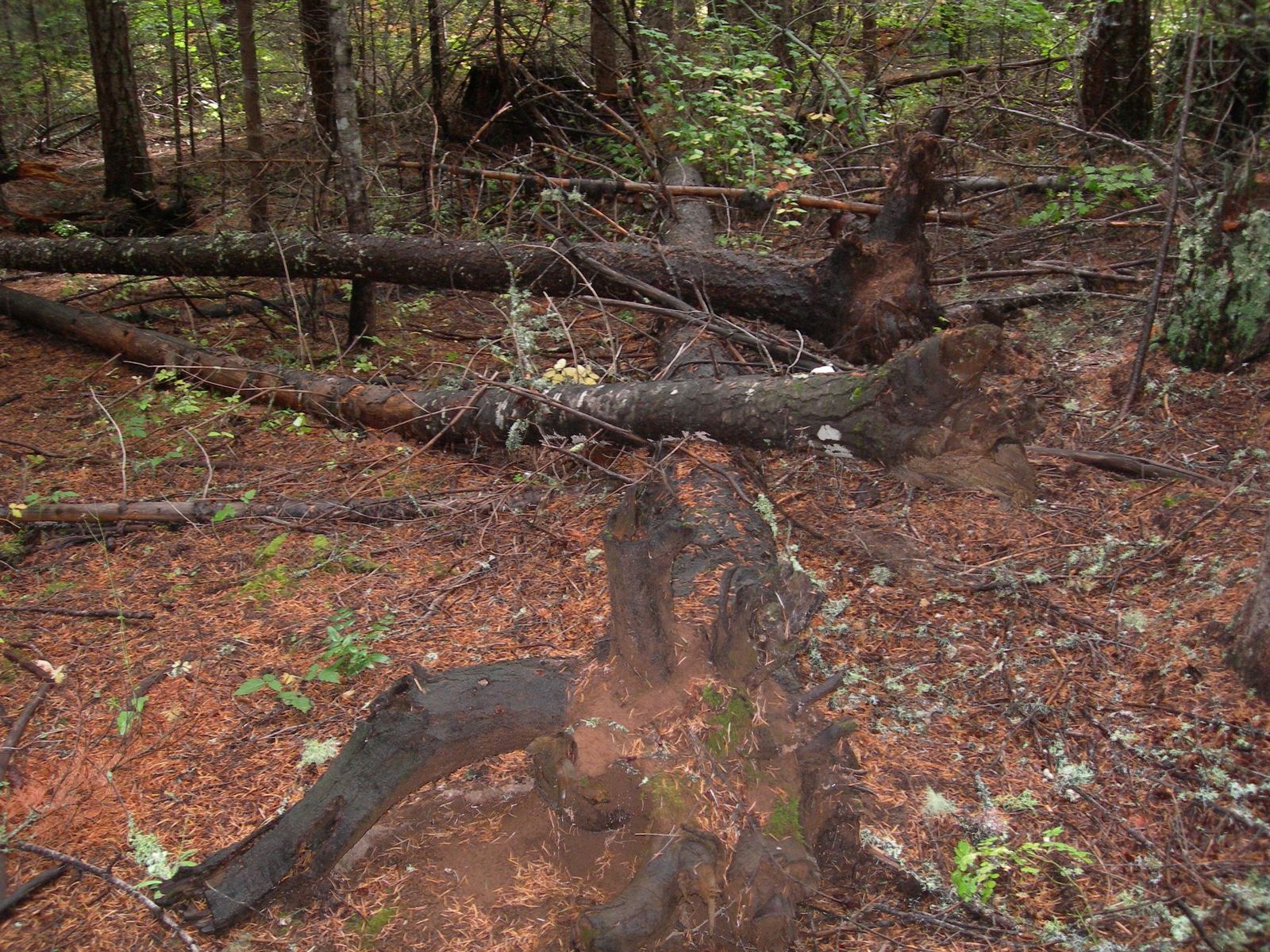
Bark beetles frequently colonize trees infected with root diseases. With the exception of droughty years and periods following large-scale outbreaks of defoliators, a very high percentage of true fir trees killed by fir engraver are infected with H. occidentale. Armillaria root disease also is frequently found on trees infected with H. occidentale.
Life History:
Spores germinate on freshly exposed wood surfaces and develop microscopic fungal threads (hyphae) that grow through woody tissues, secreting enzymes that convert the cellulose and lignin of wood cells to simple carbohydrates that the fungus uses for food. When there is contact between an infected root and a healthy root, the hyphae (masses of hyphae are called a mycelium) can grow across the contact and invade the healthy root. Mycelial growth results in death of living cells and wood decay in the sapwood and heartwood. Conks form on infected host tissues at sheltered locations on the bases and roots of host trees and in decaying stumps.
Important Habitats and Spread Dynamics:
H. occidentale is very common and causes considerable mortality east of the Cascades crest and in southwestern Oregon in stands having a high proportion of grand or white fir. In the Cascade Mountains and west of the Cascades, H. occidentale causes extensive root and butt rot in western hemlock and mountain hemlock stands, most commonly in trees older than 120 years, but at some northwest coastal Washington locations western hemlock trees as young as 50 years have extensive decay. H. irregulare commonly causes mortality of ponderosa pine and associated western juniper growing on very poor, dry Eastside sites.
Due to dissemination and spread characteristics, heterobasidion root disease is more prevalent and widely distributed in mature stands that have experienced multiple entries associated with selective harvest activities than in unharvested stands or in those that have had a single entry. Incidence within a stand is often higher along skid trails and yarding corridors where residual tree wounding occurs more frequently than in other parts of the stand.
H.occidentale and H. irregulare spread long distances aboveground via airborne spores, and locally underground through mycelial growth across host tree root contacts. Freshly cut host tree stumps generally greater than 45 cm (18 in) in diameter (except for subalpine fir, in which 20 cm (8 in) diameter stumps can act as infection centers) and host trees with large (> 900 cm2, or 1 ft2) wounds provide favorable and important habitat for colonization and spread. Stump and wound surfaces may remain susceptible to infection for 2 to 4 weeks following cutting or injury. Colonized host tree stumps (those exceeding the previously mentioned diameter thresholds), and colonized wounded host trees serve as “centers” of gradually expanding root disease infection areas as the fungus slowly moves down colonized tree roots and up the roots of previously uninfected individuals. Rates of expansion are estimated at 0.5 to 1.5 m (1 1/2 to 3 ft) per year. The pathogen dies out within a few years in small stumps less than 15 cm (6 in), but may persist in large stumps for 50 to 60 years.
Opportunities for Manipulation to Increase Wildlife Habitat:
Buffered areas that include entire heterobasidion root disease infection centers with some surrounding non-infected area may be retained in managed stands to provide a steady supply of short-term snags and down wood. Non-host buffers may require periodic maintenance to prevent unintended spread of the root disease into other areas of the stand. This approach would be appropriate for areas where root disease infection centers are discreet and not diffuse, and when the stand surrounding the buffered area is being converted to non-host species.
Potential Adverse Effects:
H. occidentale and H. irregulare can have profound effects upon forest composition, density, structure, and succession when widely distributed throughout a stand or landscape composed of highly susceptible host trees. Heterobasidion root disease may cause undesired reductions in stand densities, limit the species of trees which can be grown to a large size on a site, and cause high rates of mortality. The abundant down wood resulting from high levels of root disease infection may increase ground fire severity. Losses are greatest east of the Cascades crest and in southwest Oregon in partially cut stands of pure grand fir and white fir, or where fir basal area exceeds 20 m2 per hectare, total stand basal area exceeds 75 m2 per hectare, and stand age exceeds 120 years. Pine mortality may be high on eastside poor, dry sites where few other tree species can grow. On recreational and administrative sites, forest work sites, and along roadsides, trees with heterobasidion root disease have a high potential for failure and can present a significant safety hazard.
How to Minimize the Risk of Adverse Effects:
When managing highly susceptible species such as grand fir or white fir, adverse effects are best minimized by limiting rotations to 120 years or less, minimizing the number of harvest entries, and limiting tree wounding during harvest entries. In southwest Oregon and on the Eastside, new infections by H. occidentale or H. irregulare can be minimized by treating recently cut stump surfaces with a registered borate fungicide to prevent spore germination.

References
Goheen, E.M. and E.A. Willhite. 2006. Field guide to common diseases and insect pests of Oregon and Washington conifers. USDA Forest Service, Pacific Northwest Region, Portland, OR. R6-NR-FID-PR-01-06. 335 pp. http://www.biodiversitylibrary.org/bibliography/80321#/summary
Filip, G.M., J. Brio, K.L. Chadwick, D.J. Goheen, E.M. Goheen, J.S. Hadfield, A. Kanaskie, H.S.J. Kearns, H.M. Maffei, K.M. Mallams, D.W. Omdal, A.L. Saavedra, and C.L. Schmitt. 2014. Field guide for hazard-tree identification and mitigation on developed sites in Oregon and Washington forests. USDA Forest Service, Pacific Northwest Region, Portland, OR. R6-NR-TP-021-2013. 120 pp.
Hadfield, J.S., D.J. Goheen, G.M. Filip, C.L. Schmitt, and R.D. Harvey. 1986. Root diseases in Oregon and Washington conifers. USDA Forest Service, Pacific Northwest Region, R6-FPM-250-86. 27 pp.
Otrosina, W.J., M. Garbelotto. 2010. Heterobasidion occidentale sp. nov. and Heterobasidion irregulare nom. nov.: A disposition of North American Heterobasidion biological species. Fungal Biology 114, 16–25.
Otrosina, W.J., and R.F. Scharpf, tech. cords. 1989. Research and management of annosus root diseases (Heterobasidion annosum) in western North America. USDA Forest Service, Pacific Southwest Research Station, Gen. Tech. Rep. PSW-116. 177 pp.
Schmitt, C.L., J.R. Parmeter, and J.T. Kliejunas. 2000. Annosus root disease of western conifers. Forest Insect and Disease Leaflet 172. USDA Forest Service, Washington, D.C. 9 pp.
Website links
Western Forest Insects and Diseases: Publications and Links
Forest Insect and Disease Leaflets - Heterobasidion Root Disease